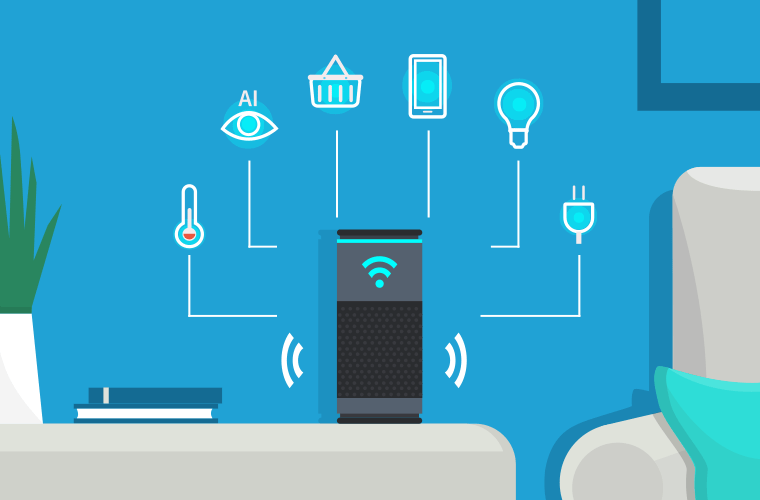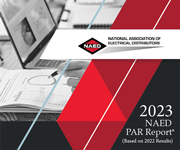Amazon’s ‘Alexa’ and other cloud-based voice services (including Google’s ‘Assistant,’ Microsoft’s ‘Cortana,’ and Apple’s ‘Siri’) were officially among the most popular gifts given this holiday season and continue to become a mainstay in the smart home… so much so that users are increasingly bringing their intelligent personal assistants with them to the workplace. As the use of these devices continues to grow in professional settings, several lighting manufacturers weigh in on how commercial systems like lighting will need to be able to adapt, adopt, and perform in the Age of Alexa as well as what distributors and manufacturers will need to know and do to prepare.
The Case for Commercial Use
“Voice recognition and intelligence engines are greatly changing how we interact with our digital and physical environments, including our lighting, with people increasingly using this technology in their personal lives and becoming more accustomed to using voice commands as a way to make their workday and lives easier,” confirmed Aaron Ganick, global head of Smart Business at LEDVANCE (www.sylvania.com), who believes that these systems will play an increasing role in commercial settings. “Similar to how daily use of mobile app-based smart devices began first with consumers and have since become ubiquitous in the workplace, voice control could very well become the next biggest technology interface in the professional world – enabling users to search the internet, perform quick calculations, set up meetings, send e-mails, and control building systems like lighting, temperature, music, and security. All of these experiences and more will be able to be done naturally and seamlessly using voice control,” Ganick said.
Matthew Ochs, director of product management at Lutron (www.lutron.com), agreed. As comfort with automated office assistants will likely stem from familiarity with these technologies in the home, “automated and voice-enabled technologies like Alexa will definitely impact commercial facilities — after all, as new technologies are embraced in the home, it seems clear that users will expect the same control conveniences in commercial spaces and work environments,” he said.
“A smart office space and smart office technology should make it obvious and easy for a new occupant to change system settings, and automated lighting control strategies such as occupancy sensing, daylight harvesting, and dimming controls can already adjust lighting in response to occupancy and reduce lighting levels in response to daylight,” Ochs said. “Voice-activated control may be able to further simplify environmental adjustments, allowing a user to say, for example, ‘Alexa, activate meeting scene,’ or ‘turn on projector scene.'”
Based on the unique properties of professional settings, however, Ochs believes that the extent and speed of voice-control adoption there remains to be seen. “Because commercial facilities feature more shared and infrequently-used spaces than residences, occupants may be less familiar with how to set up the room; e.g., they’re likely to wonder how to work the projector, turn the lights down near the projector, etc.,” he said.
Factors for Consideration
According to Ochs, manufacturers and distributors need to continue becoming more IT and IoT-savvy in order for lighting and control systems to integrate with new forms of control such as Alexa. “With cloud technology and open APIs (application programming interfaces) enabling new forms of integration and control between systems at an ever-increasing rate, the barriers and silos between the electrical/facility management world and the IT world will continue to break down and these systems will increasingly deliver coordinated, responsive control that improves the building environment,” Ochs said. “Lighting manufacturers and distributors will need to embrace this change or they’ll be left behind.”
According to our experts, other factors will also impact how intelligent personal assistants integrate with a building’s lighting and are subsequently managed. Among those factors are considerations related to the ability of artificial intelligence systems to listen, record, and process spoken dialogue to solve both mundane and challenging tasks. While these represent impressive advances in technology, “businesses and manufacturers need to think about how these capabilities impact privacy, compliance, and regulations in their spaces and products,” Ganick said. “Since devices like Alexa are potentially always listening and capturing data, they may have access to proprietary information spoken among employees or guests. Business owners will want to feel confident that they have control over their data in order for voice control and artificial intelligence to achieve mass adoption, which requires that employees be trained not just on how to use the technology, but also on how to keep sensitive information secure. This shouldn’t prevent the adoption of voice control,” Ganick said, “but it’s still an important consideration with any installation.”
At Philips Lighting (www.lighting.philips.com), Heather Milcarek, head of professional channel marketing, confirmed that the introduction of voice-enabled smart home platforms like Amazon Alexa have changed how we interact with light, adding that their Philips Hue is the first smart lighting system for the home that can be used with all of the leading voice assistants, making it easy to control lights in the home hands-free, simply by asking. As it relates to professional settings, however, “the various requirements and applications of voice control in a commercial environment are evaluated based on a much different set of criteria than residential settings,” she explained. “Through ongoing conversations with our customers about their needs and challenges, voice control authorization, recognition reach, and other capabilities in the professional arena are still in very early stages.”
Preparing for Progress
Going forward, Lutron’s Ochs noted that sustainable buildings rely on data integration rather than individual information silos that complicate decision making. “A company’s operational goals are best served with lighting control solutions that offer seamless, reliable integration with building management systems, security systems, and HVAC control using standard industry protocols such as BACnet or open APIs,” he said. “Systems that are BTL-certified offer assurance of compatibility between BACnet devices, making integration easier and more cost-effective, facilitating seamless interoperability between fixed devices, mobile devices, and external systems, and ultimately delivering smarter buildings.”
“To keep up with the latest technology,” Ochs continued, “lighting manufacturers and distributors need to focus on creating and selling systems that can very easily talk to other systems in a building because lighting control solutions will continue to be called upon to support and promote a productive, healthy lighting environment.”
LEDVANCE’s Ganick concurred, noting that what was once considered fantasy has come to fruition. “We’ve all grown up watching movies and TV shows like Star Trek featuring imagery of the far-out future where people rely on voice commands and 3D holograms to do their jobs,” he said. “While many would think that this is still something on the distant horizon, distributors and manufacturers should recognize that the future is now with voice recognition, and it isn’t just for consumer applications. For example, forward-thinking hotels are starting to add voice control in their rooms to differentiate themselves, allowing guests to control their lights and environment just by talking. As with Star Trek, distributors and manufacturers should ‘boldly go where no one has gone before’ and have conversations now on how they can capitalize on this innovation to build new sales and opportunities. To wait,” Ganick concluded, “is to be left behind in the past.”
Tagged with Alexa, smart lighting, smart office, voice control






Thanks for finally writing about > The Age of Alexa – lightED < Liked it!